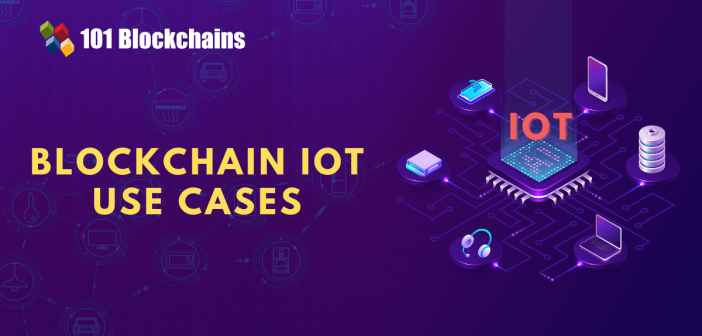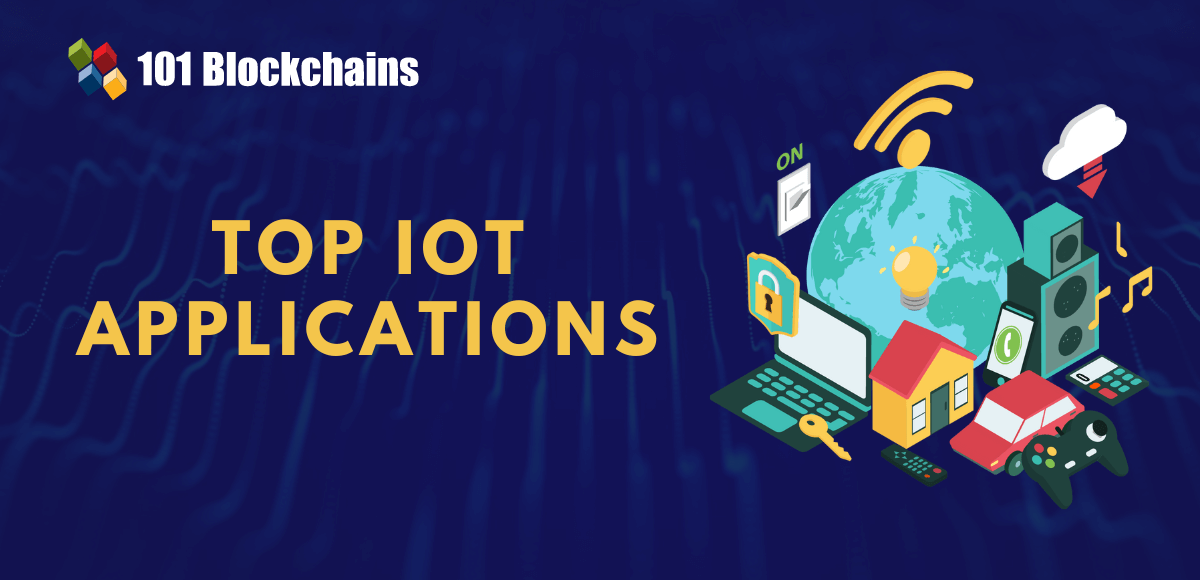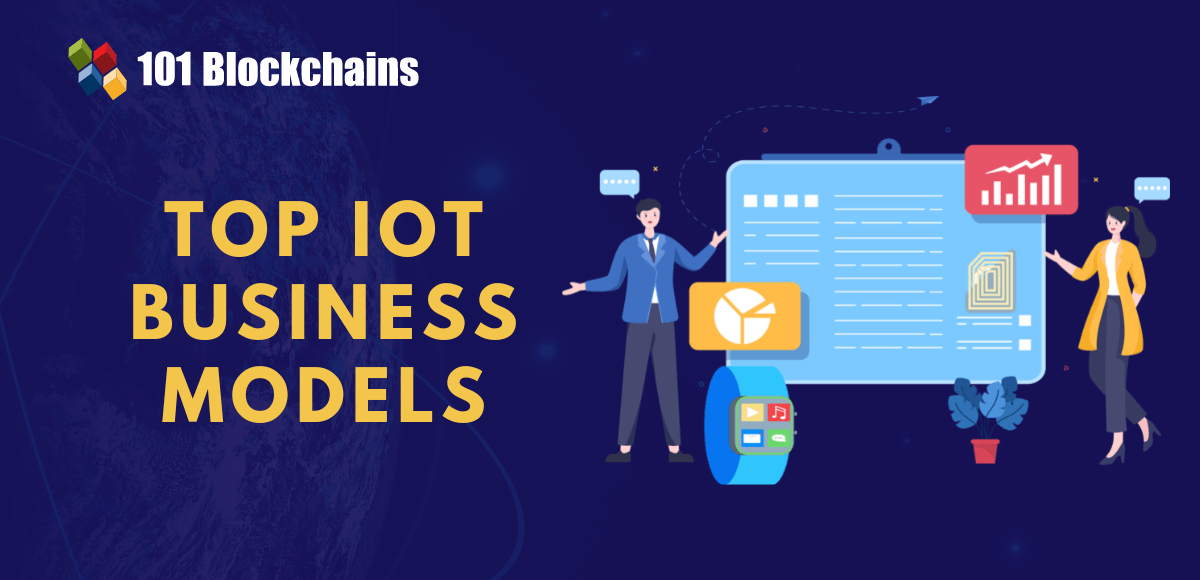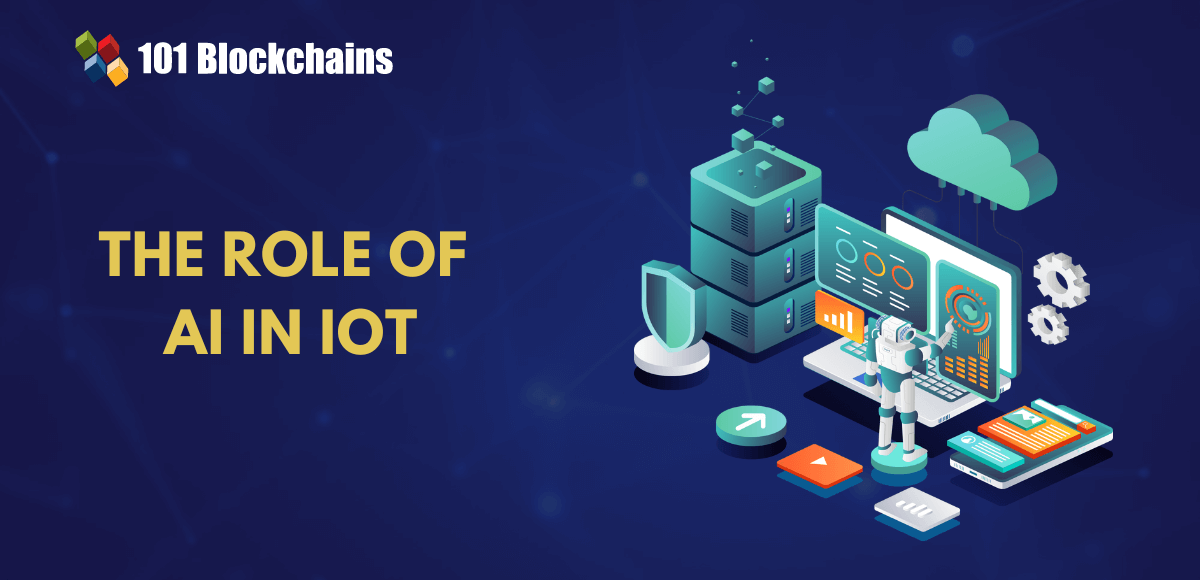Learn how blockchain truly works, master key definitions, and uncover what makes smart contracts so "smart." Dive into the fundamentals, gain valuable insights, and start your blockchain journey today!

- IoT
Diego Geroni
- on July 02, 2021
Blockchain with IoT – Top Blockchain IoT Use Cases
Blockchain technology has transformed many conventional perceptions regarding technology. As a distributed digital ledger, it has gained promising attention for its applications in various sectors after 2014. Blockchain gets the credit of being an instrument for rapidly accelerating evolution across various sectors other than the financial services companies. The focus on blockchain IoT use cases has been gaining attention among enterprises in recent times.
Rather than just leveraging the simple, shared, immutable ledger for recording transactions and tracking assets, blockchain could transform the way IoT devices send information to each other and take decisions. The following discussion would offer a detailed impression of IoT blockchain use cases. However, readers would find the most important highlight in terms of understanding how blockchain can influence the IoT space.
Want to learn how you can use blockchain in the Internet of Things (IoT)? Enroll now in Blockchain And IoT Course
The Blockchain and IoT Equation
Before starting with a reflection on different use cases of blockchain in IoT, it is important to understand ‘How blockchain can be used in IoT?’ effectively. Blockchain has already been through a radical evolution process alongside reaching the peak of hype followed by a trough of disillusionment. Now, it is slowly coming back on track again towards an upward trend. Many recent events and their related influence on the connected economy have led to new standards for digitalizing transactions.
Blockchain gives the perfect technology foundation for enabling digital transactions among organizations. Blockchain helps in the secure recording of transactions along with the assurance of immutability throughout different computers associated with each other in a peer-to-peer network. The emphasis on blockchain IoT projects largely draws strength from such traits in blockchain technology. In order to get a better understanding of how blockchain can help IoT projects, it is important to delineate its working in the context of IoT ecosystems.
The Working of Blockchain Technology for IoT Use Cases
The uses of blockchain IoT depend prominently on the three basic traits of blockchain technology in the form of a data structure. The three basic properties of blockchain technology that could benefit IoT use cases include,
- Distribution
- Decentralization
- Immutability
A simple explanation of using these three blockchain properties for improving IoT use cases could verify the feasibility of blockchain IoT projects. Let us assume the example of surveillance cameras as IoT devices to understand how these three traits could benefit IoT. Now, if a burglar wants to compromise a surveillance camera and prevent the crime from being recorded, they can attack the server that runs the database storing the videos.
Want to understand the fundamentals of the Internet of Things (IoT)? Enroll Now in IoT Fundamentals Course!
1. Distribution
With blockchain, the data does not stay in a single place and is distributed throughout different computers on the network. As a result, it is quite difficult to hack the surveillance system with multiple target devices. In addition, the redundancy in storage offered by blockchain improves security and data access. How? Users in the IoT ecosystems could easily submit and retrieve their desired data from various devices effortlessly.
2. Immutability
The blockchain IoT use cases are also evident in examples where the burglar might claim that video evidence recorded by surveillance cameras is forged. In such cases, the immutability of blockchain comes to mind. It implies the detection of any changes in the stored data. As a result, the court could verify the burglar’s claim by searching for attempts to modify the data.
3. Decentralization
Although immutability and distribution safeguard the integrity of IoT device data on blockchain networks, decentralization could be a prominent setback. Decentralization could open up sensitive data of users to third parties. However, it is possible to find a way around such setbacks. The IoT blockchain use cases could involve the storage of access logs and permissions as a preferred solution.
With the distribution and decentralization traits of blockchain, big data storage can be exceptionally expensive. So, the favorable alternative, in this case, would be the storage of data in a central repository. At the same time, the logs of data access would go on a blockchain network. As a result, users can get an immutable data structure with the flexibility of identifying the identity of individuals accessing data and the time of the event.
Build your identity as a certified blockchain expert with 101 Blockchains’ Blockchain Certifications designed to provide enhanced career prospects.
Use Cases of Blockchain IoT
Blockchain has the capability to empower IoT devices with better security and transparency in IoT ecosystems. It presents a scalable and decentralized environment tailored for IoT devices, applications, and platforms. Blockchain IoT examples are starting to make a name among popular banks and financial institutes such as ING, HSBC, and Deutsche Bank.
Other than financial institutions, many companies have also planned on using the opportunities with IoT for smart business operations. So, blockchain IoT applications have made their way to different sectors in recent times. Let us find out how blockchain and IoT together can deliver prolific business value across industries.
-
Supply Chain Management
Supply chain management is one of the foremost examples of sectors with promising blockchain IoT projects. The global supply chain network includes various stakeholders, including brokers as well as raw material providers. As a result, it can be responsible for introducing complications in end-to-end visibility into the supply chain. Interestingly, the supply chain could also involve various payments as well as invoices, extending the duration of fulfilment by months. In addition, the participation of multiple stakeholders also results in delays in delivery.
Enterprises are working on the uses of IoT and blockchain together by making IoT-enabled vehicles responsible for tracking shipments. The combination of blockchain and IoT could improve the reliability and traceability of the network. IoT sensors could provide crucial information about the shipment status. Some of the notable IoT sensors include,
- Temperature sensors
- Motion sensors
- Connected devices
- GPS
- Vehicle information
The blockchain IoT examples in supply chain management then store the sensor information on the blockchain. After saving data on the blockchain, stakeholders defined in the smart contracts could obtain real-time information access. As a result, stakeholders in the supply chain could prepare adequately for transactions across different shipments and borders.
The most prominent example of using blockchain and IoT functionalities together in supply chain management refers to Golden State Foods. It is a diversified supplier specializing in the manufacture and distribution of food products. Golden State Foods has collaborated with IBM for the optimization of its supply chain processes through IoT and blockchain.
Want to know more about blockchain and supply chain management? Enroll Now in Blockchains and Supply Chain Management Course!
-
Smart Homes
The application of blockchain and IoT in smart homes gives another perfect answer to ‘How blockchain can be used in IoT?’ with ease. IoT-enabled devices have provided the ideal foundation for encouraging the concept of smart homes. With the help of IoT blockchain, smart homes could find better ways to manage home security systems remotely from smartphones. Blockchain removes the concerns associated with the conventional centralized approach for exchanging information generated through IoT devices.
One of the notable blockchain IoT examples in the field of smart homes refers to Telstra. The Australian telecommunication giant offers smart home solutions powered by blockchain and biometric security. The smart home solutions offered by Telstra ensure the storage of sensitive user data on the blockchain for better security. The sensitive user data could be related to,
- Facial recognition
- Biometrics
- Voice recognition
After recording data on the blockchain, the immutability trait ensures that only authorized individuals can obtain access to smart homes.
Want to familiarize yourself with the technology stack associated with IoT? Enroll Now in IoT Intermediate Level Course
-
Pharmacy
The blockchain IoT use cases in the pharmaceutical sector focus on addressing critical issues such as counterfeit medicines. The pharmaceutical industry takes care of the development, manufacturing, and distribution of drugs, thereby creating difficulties in tracking the complete lifecycle of drugs. The traceability and transparency associated with blockchain could help in monitoring the shipment of drugs from the point of manufacturing to the end-user.
The most prolific example of the use of blockchain IoT in the pharmacy sector is Mediledger. It is a blockchain IoT application developed for tracking legal changes in ownership of prescription medicines. Monitoring sensitive healthcare products require a focus on traceability and transparency. Mediledger ensures that data on the blockchain has the right and accurate timestamp. It is immutable and allows access only to,
- Wholesalers
- Manufacturers
- Distributors
- End customers
Mediledger offers a simple interface for using blockchain and IoT functionalities together for many value-based benefits. It can ensure the following advantages,
- Offering comprehensive control over user access
- Preventing the increasing growth of counterfeit drugs in the global pharma supply chain
- Enabling simpler and easily navigable payment processes with better security
Do you think whether blockchain in pharma will work or not? Check out our guide to know Why Blockchain Can Be A Game Changer For Pharma!
-
Automotive Sector
The impact of digitalization has resulted in the prolific growth of its competitive demand. Automotive industries have been successfully utilizing IoT-enabled sensors for the development of completely automated vehicles. One of the most prolific uses of blockchain IoT can be identified in the automotive sector for connecting blockchain with industrial IoT solutions. As a result, it can empower multiple users for easier and faster exchange of crucial information.
The automotive sector provides the most favorable platform for encouraging the use cases of blockchain IoT. The combination of blockchain and IoT could result in profound disruptions throughout the automotive sector such as,
- Smart parking
- Automated traffic control
- Automated fuel payments
- Autonomous cars
One of the notable examples of blockchain IoT use cases in the automotive industry refers to NetObjex. It is actually a smart parking solution that leverages the best of both blockchains as well as IoT. The integration of both technologies is useful for simplifying the process of locating a vacant space in parking lots. In addition, NetObjex can also facilitate the automation of payments through the use of crypto wallets.
NetObjex has entered into a partnership with parking sensor company, PNI, to improve the efficiency of real-time vehicle detection. Collaboration is also one of the driving forces for improving efficiency in finding the availability of parking areas. The IoT sensors in NetObjex carry out calculations of charges for the parking duration. On the other hand, the crypto wallet leverages blockchain for handling billing tasks.
Check out our ON-DEMAND Webinar on Industrial Blockchain now!
-
Agriculture
The search for answers to “How blockchain can be used in IoT?” can take you to the domain of agriculture too. IoT finds new and revolutionary applications in the field of agriculture, especially for tracking the impact of weather and other external factors on crop quality and yield. However, the emphasis on ensuring maximum customer satisfaction in agriculture has drawn attention to factors beyond improving food production.
Apart from growing more food for the increasing population, the agriculture sector must also focus on reducing its environmental footprint. At the same time, enterprises in the field of agriculture want to garner customer trust through improved transparency throughout the supply chain.
The blockchain IoT examples for the food production industry have promising potential for transforming the industry. Blockchain IoT applications could help in improving the traceability of food products from farms to grocery stores to homes. The installation of IoT sensors in farms followed by the transmission of the data directly to the blockchain could improve the food production supply chain considerably. Let us take a look at one of the use cases of blockchain IoT for enhancing the agricultural supply chain.
Pavo is an ideal example of using blockchain IoT for transforming the agriculture sector and its conventional precedents. It is just another blockchain IoT use case aimed at delivering a new and smart approach to farming alongside unmatched levels of transparency. The IoT hardware devices of Pavo installed on the farms collect crucial information and save it on the blockchain network.
Pavo could help farmers in reviewing the collected data for improving farming techniques. At the same time, distributors, consumers, and retailers could also make improved informed decisions regarding agricultural purchases. Pavo marketplace also enables farmers to pre-selling crops through smart contracts without having to wait for payments after harvest.
-
Sharing Economy
The world has been slowly warming up to the concept of a sharing economy. Blockchain IoT use cases tend to present a viable foundation for supporting the sharing economy. Blockchain could help in the creation of decentralized, shared economy applications. These applications could help in achieving promising levels of revenue through the seamless sharing of goods and services. For example, imagine the possibility of an Airbnb apartment leasing out itself according to vacancy and planned bookings. Slock.it is one of the most promising instances of applying blockchain IoT in shared economy applications.
Slock.it is making huge strides in transforming the sharing economy business through the use of blockchain technology. The platform utilizes blockchain technology for ensuring flexibility in sharing IoT-enabled devices or objects. Interestingly, the platform also plans on developing a Universal Sharing Network or USN. The USN could facilitate a secure online marketplace of connected things.
In addition, USN could help in renting, sharing, or selling any object with the highest level of security in the absence of any intermediaries. Third parties such as manufacturers could ensure the onboarding of any object to the USN without having to seek permission explicitly. Additionally, smart contracts could offer the desired levels of data transparency and privacy through exerting control over access to information.
Start learning Blockchain IoT with World’s first IoT (Internet Of Things) Skill Path with quality resources tailored by industry experts Now!
-
Water Management
The different blockchain IoT projects for water management have also gained profound attention in recent times. Water management is an essential necessity for sustainability as faulty water fixtures lead to waste of almost one trillion gallons of water annually in the USA.
The most promising example of using blockchain IoT in water management is Aquai. The company has developed a smart water sensor known as Puck. It could help in tracking the amount of water usage alongside automating water shutdown in event of detecting any leak. Interestingly, Aquai also leverages the IoT and blockchain services of NetObjex for monitoring and storing data. Aquai has also suggested plans for introducing new services associated with water damage resulting from leaks.
In addition, IoT blockchain use cases have also found notable recognition in water management with another project proposed for combating river contamination. With the involvement of two companies, namely Airalab and Libelium, a new project has found its roots in leveraging the blockchain and IoT combination to fight water contamination. The project, known as ‘Drone on the Volga’, would utilize a drone-powered with IoT sensors and blockchain technology for collecting data on water contamination levels independently.
The drone in the project would be responsible for collecting water readings in the Kuybyshev Reservoir of the Volga River. Then, it would store the data on the Ethereum blockchain and publish it in real-time. The drone could leverage IoT functionalities to understand the place and time of taking readings. As a result, scientists could easily identify the source of contamination in the river precisely.
Start learning Blockchain with World’s first Blockchain Career Paths with quality resources tailored by industry experts Now!
Bottom Line
The scope of blockchain IoT use cases is not limited only to a few sectors. Apart from the supply chain, pharmacy, and smart homes, blockchain and IoT could serve many prolific advantages for the automotive industry, water management, and agriculture. Most important of all, blockchain and IoT use cases could encourage the prospects of sharing economy.
With promising capabilities such as immutability, transparency, and flexibility for auditing, blockchain could empower IoT ecosystems worldwide. The billions of IoT-enabled devices throughout the world offer the perfect foundation for creating a new ecosystem for secure information exchange and smarter lives. Learn more about the applications of blockchain in IoT right now!






